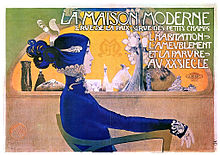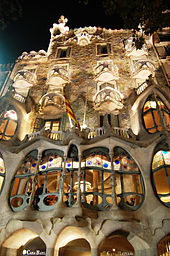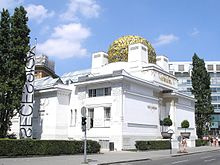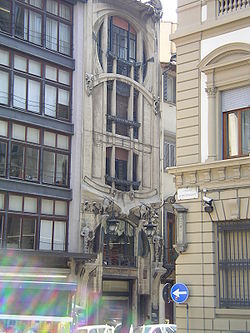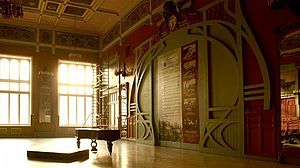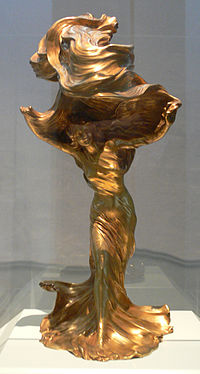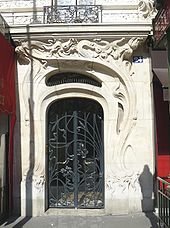
Art Nouveau
Did you know...
This selection is made for schools by a children's charity read more. With SOS Children you can choose to sponsor children in over a hundred countries
Art Nouveau (French pronunciation: [aʁ nu'vo], Anglicised to / ˈ ɑː r t n uː ˈ v oʊ /) is an international philosophy and style of art, architecture and applied art—especially the decorative arts—that were most popular during 1890–1910. The name "Art Nouveau" is French for "new art". It is known also as Modernisme in Catalonia (Spain), with its most notable contributions by the architect Antoni Gaudí. Known as Jugendstil, pronounced [ˈjuːɡn̩tstiːl ]in Germany, German for "youth style" or "the style of youth", named after the magazine Jugend, which promoted it, as Modern (Модерн) in Russia, perhaps named after Parisian gallery "La Maison Moderne", as Secession in Austria-Hungary and its successor states after the Viennese group of artists, and, in Italy, as Stile Liberty from the department store in London, Liberty & Co., which popularised the style. A reaction to academic art of the 19th century, it was inspired by natural forms and structures, not only in flowers and plants but also in curved lines. Architects tried to harmonize with the natural environment. It is also considered a philosophy of design of furniture, which was designed according to the whole building and made part of ordinary life.
The style was influenced strongly by Czech artist Alphonse Mucha, when Mucha produced a lithographed poster, which appeared on 1 January 1895 in the streets of Paris as an advertisement for the play Gismonda by Victorien Sardou, featuring Sarah Bernhardt. It popularised the new artistic style and its creator to the citizens of Paris. Initially named Style Mucha, (Mucha Style), his style soon became known as Art Nouveau.
Art Nouveau was most popular in Europe, but its influence was global. Hence, it is known in various guises with frequent localised tendencies. In France, Hector Guimard's Paris metro entrances were of art nouveau style and Emile Gallé practised the style in Nancy. Victor Horta had a decisive effect on architecture in Belgium. Magazines like Jugend helped publicise the style in Germany, especially as a graphic artform, while the Vienna Secessionists influenced art and architecture throughout Austria-Hungary. Art Nouveau was also a style of distinct individuals such as Gustav Klimt, Charles Rennie Mackintosh, Alphonse Mucha, René Lalique, Antoni Gaudí and Louis Comfort Tiffany, each of whom interpreted it in their own manner.
Although Art Nouveau was replaced by 20th-century modernist styles, it is considered now as an important transition between the historicism of Neoclassicism and modernism. Furthermore, Art Nouveau monuments are now recognised by UNESCO with their World Heritage List as significant contributions to cultural heritage. The historic centre of Riga, Latvia, with "the finest collection of art nouveau buildings in Europe", was included on the list in 1997 in part because of the "quality and the quantity of its Art Nouveau/Jugendstil architecture", and four Brussels town houses by Victor Horta were included in 2000 as "works of human creative genius" that are "outstanding examples of Art Nouveau architecture brilliantly illustrating the transition from the 19th to the 20th century in art, thought, and society".
Naming the style
At its beginning, neither Art Nouveau nor Jugendstil was the common name of the style but was known as this in some locations, and the style had different names as it was spread. Those two names came from, respectively, Samuel Bing's gallery Maison de l'Art Nouveau in Paris and the magazine Jugend in Munich, both of which promoted and popularised the style.
Bing's Maison de l'Art Nouveau
Maison de l'Art Nouveau (House of New Art) was the name of the gallery initiated in 1895 by the German art dealer Samuel Bing in Paris that featured exclusively modern art. The fame of his gallery was increased at the 1900 Exposition Universelle, where he presented coordinated—in design and colour—installations of modern furniture, tapestries and objets d'art. These decorative displays became so strongly associated with the style that the name of his gallery subsequently provided a commonly used term for the entire style.
Jugend and Jugendstil
Jugend: Münchner illustrierte Wochenschrift für Kunst und Leben (English: Youth: the illustrated weekly magazine of art and lifestyle of Munich) was a magazine founded in 1896 by Georg Hirth (Hirth remained editor until his death in 1916, and the magazine continued to be published until 1940). The magazine was instrumental in promoting the style in Germany. As a result, its name was adopted as the most common German-language term for the style: Jugendstil ("young style"), although, during the early 20th century, the word was applied to only two-dimensional examples of the graphic arts, especially the forms of organic typography and graphic design found in and influenced by German magazines like Jugend, Pan, and Simplicissimus. It is now applied to more general manifestations of Art Nouveau visual arts in Germany, the Netherlands, the Baltic states, and Nordic countries.
Other names
Other local names were associated with the characteristics of its forms, its practitioners and their works, and schools of thought or study where it was popular. Many of these terms refer to the idea of "newness". Before the term "Art Nouveau" became common in France, le style moderne ("the modern style") was the more frequent designation. Arte joven ("young art") in Spain, Modernisme in Catalonia, Arte nova in Portugal ("new art"), Arte nuova in Italy (also "new art"), and Nieuwe kunst ("new art") in the Netherlands, модерн ("new", "contemporary") in Russia – all continue this theme. Many names refer specifically to the organic forms that were popular with the Art Nouveau artists: Stile Floreal ("floral style"), Lilienstil ("lily style"), Style Nouille ("noodle style"), Paling Stijl ("eel style"), and Wellenstil ("wave style").
In other cases, important examples, well-known artists, and associated locations influenced the names. Hector Guimard's Paris Métro entrances, for example, provided the term Style Métro, the popularity in Italy of Art Nouveau designs from London's Liberty & Co department store resulted in its being known as the Stile Liberty ("Liberty style"), and, in the United States, it became known as the "Tiffany style" due to its association with Louis Comfort Tiffany. In Austria, a localised form of Art Nouveau was practised by artists of the Vienna Secession, and it is, therefore, known as the Sezessionstil ("Secession style"). As a stand-alone term, however, "Secession" (German: Sezession, Hungarian: szecesszió, Czech: secese) is used frequently to describe the general characteristics of Art Nouveau style outside Vienna, but mostly in areas of Austria-Hungary at the beginning of the 20th century. In the United Kingdom, it is associated with the activities of Charles Rennie Mackintosh in Glasgow, and is often known as the "Glasgow" style.
Art Nouveau tendencies were also absorbed into local styles. In Denmark, for example, it was one aspect of Skønvirke ("aesthetic work"), which itself more closely relates to the Arts and Crafts style. Likewise, artists adopted many of the floral and organic motifs of Art Nouveau into the Młoda Polska ("Young Poland") style in Poland. Młoda Polska, however, was also inclusive of other artistic styles and encompassed a broader approach to art, literature, and lifestyle.
Origins
The origins of Art Nouveau are found in the resistance of the artist William Morris to the cluttered compositions and the revival tendencies of the 19th century and his theories that helped initiate the Arts and crafts movement. However, Arthur Mackmurdo's book-cover for Wren's City Churches (1883), with its rhythmic floral patterns, is often considered the first realisation of Art Nouveau. About the same time, the flat perspective and strong colors of Japanese wood block prints, especially those of Katsushika Hokusai, had a strong effect on the formulation of Art Nouveau. The Japonisme that was popular in Europe during the 1880s and 1890s was particularly influential on many artists with its organic forms and references to the natural world. Besides being adopted by artists like Emile Gallé and James Abbott McNeill Whistler, Japanese-inspired art and design was championed by the businessmen Siegfried Bing and Arthur Lasenby Liberty at their stores in Paris and London, respectively.
Character
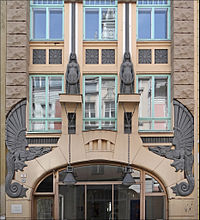
Although Art Nouveau acquired distinctly localised tendencies as its geographic spread increased, some general characteristics are indicative of the form. A description published in Pan magazine of Hermann Obrist's wall hanging Cyclamen (1894) described it as "sudden violent curves generated by the crack of a whip", which became well known during the early spread of Art Nouveau. Subsequently, not only did the work itself become better known as The Whiplash but the term "whiplash" is frequently applied to the characteristic curves employed by Art Nouveau artists. Such decorative "whiplash" motifs, formed by dynamic, undulating, and flowing lines in a syncopated rhythm, are found throughout the architecture, painting, sculpture, and other forms of Art Nouveau design.
Philosophy and geography
Art Nouveau is now considered a 'total' style, meaning that it includes a hierarchy of scales in design—architecture; interior design; decorative arts including jewellery, furniture, textiles, household silver and other utensils and lighting; and the visual arts (see Hierarchy of genres.) According to the philosophy of the style, art should be a way of life. For many Europeans, it was possible to live in an art nouveau-inspired house with art nouveau furniture, silverware, crockery, jewellery, cigarette cases, etc. Artists desired to combine the fine arts and applied arts, even for utilitarian objects.
International expos
Part of the evolution of Art Nouveau was the Exposition Universelle of 1900 in Paris, which presented an overview of the 'modern style' in every medium. It achieved further recognition at the Esposizione Internazionale d'Arte Decorativa Moderna of 1902 in Turin, Italy, where designers exhibited from almost every European country where Art Nouveau was practiced.
France, Belgium and Switzerland
In Paris, the Maison de l'Art Nouveau, at the time managed by Siegfried Bing, showcased art nouveau objects. Artists such as Émile Gallé, Louis Majorelle and Victor Prouvé in Nancy, France, founded the École de Nancy, giving Art Nouveau a new influence. In Brussels, Belgium the style was developed with the help of the architects Victor Horta and Henry Van de Velde. Other Art Nouveau designers in Belgium, Switzerland, and France include Theophile Alexandre Steinlen, Hector Guimard, and Jules Lavirotte. The Czech artist Alphonse Mucha worked in Paris for a number of years.
Spain
In Spain, the style was based mainly in Barcelona and was an essential element of the Catalan Modernisme. Architect Antoni Gaudí, whose decorative architectural style is so personal that he is sometimes considered as practising an artistic style different from Art Nouveau, nonetheless uses Art Nouveau's floral and organic forms. His designs from about 1903, the Casa Batlló (1904–1906) and Casa Milà (1906–1908), are most closely related to the stylistic elements of Art Nouveau. However, famous structures such as the Sagrada Familia characteristically contrast the modernising Art Nouveau tendencies with revivalist Neo-Gothic. Besides the dominating presence of Gaudí, Lluís Domènech i Montaner also used Art Nouveau in Barcelona in buildings such as the Casa Lleó Morera (1905). Another major art nouveauist was Josep Maria Jujol.
Germany
German Art Nouveau is commonly known by its German name, Jugendstil. Drawing from traditional German printmaking, the style uses precise and hard edges, an element that was rather different from the naturalistic style of the time. The style was used mainly in Hamburg. Jugendstil art includes a variety of different methods, applied by the various individual artists. Methods range from classic to romantic. One feature of Jugendstil is the typography used, the letter and image combination of which is unmistakable. The combination was used for covers of novels, advertisements, and exhibition posters. Designers often used unique display typefaces that worked harmoniously with the image.
Henry Van de Velde, who worked most of his career in Germany, was a Belgian theorist who influenced many others to continue this style of graphic art including Peter Behrens, Hermann Obrist, and Richard Riemerschmid. August Endell, Henri Privat-Livemont is another notable Art Nouveau designer.
Magazines were important for spreading the visual idiom of Jugendstil, especially the graphical qualities. Besides Jugend, other important magazines were the satirical Simplicissimus and Pan.
Austria
A localised approach to Art Nouveau is represented by the artists of the Vienna Secession, a secession that was initiated on 3 April 1897 by Gustav Klimt, Koloman Moser, Josef Hoffmann, Joseph Maria Olbrich, Max Kurzweil, Otto Wagner, and others. They objected to the conservative orientation toward historicism expressed by the Vienna Künstlerhaus.
Malta
There are Art Nouveau buildings called the Balluta Buildings. They are apartment buildings on the eastern shore of Balluta Bay, on the northeast coast of Malta within the district St. Julian's.
Britain
In the United Kingdom, Art Nouveau developed out of the Arts and Crafts Movement. The beginning of an Art Nouveau style can be recognized during the 1880s, in a few progressive designs such as the architect-designer Arthur Mackmurdo's book cover design for his essay on the city churches of Sir Christopher Wren, published during 1883. Some free-flowing wrought iron from the 1880s could also be adduced, or some flat floral textile designs, most of which owed some impetus to patterns of 19th century design. The most important centre in Britain eventually became Glasgow, with the creations of Charles Rennie Mackintosh and his colleagues.
Other notable British Art Nouveau designers include Walter Crane, Arthur Lasenby Liberty, Charles Ashbee, and Aubrey Beardsley.
The Edward Everard building in Bristol, built during 1900–01 to house the printing works of Edward Everard, features an Art Nouveau façade. The figures depicted are of Johannes Gutenberg and William Morris, both eminent in the field of printing. A winged figure symbolises the Spirit of Light, while a figure holding a lamp and mirror symbolises light and truth.
Italy
The Art Nouveau European Route provides details of the heritage in Europe and worldwide of the Art Nouveau style featuring considerable information about Italy's Stile Liberty. This represented the modern designs from the Liberty & Co store of London, indicating both Art Nouveau's commercial aspect and the 'imported' character that it retained in some parts of Italy, though not in Palermo, isolated from developments in the north and evolving an independent character due largely to designers such as architect Ernesto Basile and Vittorio Ducrot, who specialised as a cabinetmaker. According to the Art Nouveau European Route, Basile and Ducrot were responsible for the idea of the complete work of art in Italy. Important Italian Liberty cities or sites are the spa centres of Salsomaggiore Terme, Emilia-Romagna, and San Pellegrino Terme, Lombardy, as well as Cernobbio on Lake Como also in Lombardy. Some large cities have a considerable number of Liberty-style decorations and buildings, especially Turin, Milan, Naples, Florence, Genoa, and large sections of the sea-side town of Viareggio, Tuscany. The Liberty Style was used by Italian designers and architects overseas, especially in Argentina and Chile, such as at Valparaíso where architects Renato Schiavon and Arnaldo Barison, trained in Trieste, arrived after the earthquake of 1906. Here they built outstanding structures such as the Palace Barburizza (1915), now the city's Museum of Fine Arts. Other important Italian art nouveau designers were the Bugatti family ( Carlo, Ettore, Jean and Rembrandt) best known for their cars built in France, and furniture and art constructed in their native Milan. Carlo Bugatti, born February 1856 in Milan was himself the son of an architect and sculptor Giovanni Luigi Bugatti. Carlo received his training at the renowned Milanese Academy of Brera, and later the Académie des Beaux-Arts in Paris. His work was wide-ranging including silverware, textiles, ceramics, and musical instruments, but he is best remembered for his innovative furniture designs, shown first in the 1888 Milan Fine Arts Fair.
Hungary

In contrast to Historicism, Hungarian Art Nouveau is based on supposed national architectural characteristics. Ödön Lechner (1845–1914), the most important figure in Hungarian Art Nouveau, was inspired initially by Indian and Syrian architecture, and later by traditional Hungarian decorative designs. In this manner, he created an original synthesis of architectural styles. Disusing the style of Lechner, yet being inspired by his method, the group of 'Young People' (Fiatalok), which included Károly Kós and Dezső Zrumeczky, applied the characteristic structures and forms of traditional Hungarian architecture, especially the Transylvanian vernacular. Besides the two principal styles, Hungarian architecture also displays local versions of trends originating from other European countries. The Vienna Secession, the German Jugendstil, Art Nouveau from Belgium and France, and the influence of English and Finnish architecture are all represented in the buildings constructed at the beginning of the 20th century. Béla Lajta initially adopted Lechner's style, subsequently adopting English and Finnish trends; after developing an interest in the Egyptian style, he finally developed a modern architectural style. Aladár Árkay did almost the same. István Medgyaszay developed his own style, which differed from Lechner's, using stylised traditional motifs to create decorative designs in concrete. For applied arts, those mainly responsible for promoting the spread of Art Nouveau were the School and Museum of Applied Arts, which opened in 1896. Former areas in the Hungarian Kingdom, Vojvodina (northern Serbia) and Transylvania have fine examples of Hungarian art Nouveau. See Szabadka, Marosvásárhely etc.
Czech lands
Alphonse Mucha used the style in Prague and Moravia (part of the modern Czech Republic); his style of Art Nouveau became associated with the so-called Czech National Revival. Fin de siècle sections of Prague reveal modest buildings encrusted with images of leaves and women that curve and swirl across the façades. Examples of Art Nouveau in the city, along with the exteriors of any number of private apartment and commercial buildings, are the Municipal House, the Hotel Paříž, Smíchov Market Hall, Hotel Central, the windows in the St. Wenceslaus Chapel at St. Vitus Cathedral, the main railway station, the Grand Hotel and the Jubilee Synagogue. The Olšany Cemetery and the New Jewish Cemetery are also important examples of Art Nouveau. In Czech, Art Nouveau is known as secese, a name adopted from the Austrian term "Secessionism".
Latvia
Art Nouveau architecture was popular in Riga, the capital of Latvia, during the late 19th century and the beginning of the 20th century – about 40% of the buildings from this time were built in this style. Several substyles formed during this period. Early elements of the new style were added to Eclectic architecture forming "Eclectic" Art Nouveau. "Decorative" Art Nouveau refers to style using only decorative elements of the Art Nouveau; the first such building was built in 1899, however by 1906 decorative styles had become unfashionable. Therefore the decorative style is not very widespread in Riga. Most popular style in Riga is known as "Romantic" Art Nouveau. Simplistic and modern in form, these buildings were decorated with elements from other historic styles and constitute about one-third of all buildings in central Riga. From 1905 to 1911, Latvian National Romantism peaked. While being a substyle of Art Nouveau, it copied forms of traditional architecture and incorporated traditional decorative elements. As Art Nouveau matured, emphasis on vertical lines became more popular, known as "Vertical" Art Nouveau, this style was most popular shortly before World War I. The centre of Riga is now designated as a UNESCO World Heritage site in part for its Art Nouveau architecture.
Significant number of Art Nouveau structures is located also in other cities and towns of Latvia, including Liepāja (hundreds of buildings), Jūrmala (notable example – Dubulti Lutheran Church, 1907), Daugavpils and others. The use of Art Nouveau outside urban centres has been rare, but there some exquisite examples such as Luznava manor house (eastern Latvia).
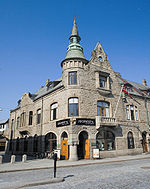
Norway
The foremost examples of Art Nouveau architecture (Jugendstil) in Norway are found in Ålesund, which was rebuilt after a major fire in 1904, while the style was particularly relevant. A representative Ålesund jugend is the former Svaneapoteket (Swan Pharmacy). Today, the Jugendstilsenteret is located in this building. It should have been applied in 1908. Apothecary Øwre was a member of the council and the presidency in Ålesund, and after that the pharmacy was adopted also mayor in the years 1909-1910. He chose the architect Hagbarth Martin Schytte-Berg (1860-1944) to draw and construct the new pharmacy. The architect was one of the leaders in the effort to restore Ålesund after the fire. His other works include Skien Church (1887-1894) and Fagerborg Church in Kristiania (Oslo) (1900-1903).
Central and Eastern Europe
In Russia, the style was promoted by the art magazine Mir iskusstva ('World of Art'), which spawned the revolutionary Ballets Russes.
The Polish style was centred in Krakow and was part of the Mloda Polska style. Stanisław Wyspiański was the main Art Nouveau artist in Poland; his paintings, theatrical designs, stained glass, and building interiors are widely admired and celebrated in the National Museum in Kraków. Art Nouveau buildings survive in most Polish cities ( Łódź, Kraków), with the exception of Warsaw, where Communist authorities destroyed the few examples that survived the Nazi razing of the city on the grounds that the buildings were decadent.
The Slovene Lands were another area influenced by Art Nouveau. At its beginning, Slovenian Art Nouveau was influenced strongly by the Viennese Secession, but it later developed an individual style. Important architects of this style include Max Fabiani, Ciril Metod Koch, Jože Plečnik, Ivan Vurnik. The vast majority of the architecture is to be found in Ljubljana.
Croatia was an area of secessionist architecture as well. Architects like Vjekoslav Bastl and Baranyai developed a mixture between modernism and classical Art Nouveau. The Croat architect Josip Vancaš worked mostly in Sarajevo, the capital of Bosnia and Hercegovina. His architecture was a mixture of earlier historicism and proper Art Nouveau: some of his finest Art Nouveau buildings are located in Ljubljana, Slovenia.
Other areas
The spread of Art Nouveau (Arte nova) in Portugal, although delayed due to slowly developing industry, flourished in cities like Oporto and Aveiro, in which can be found numerous buildings influenced by European models, in particular by French architecture.
Art Nouveau was also popular in the Nordic countries, where it became integrated with the National Romantic Style. Good examples are the neighbourhoods of Katajanokka and Ullanlinna in Helsinki, Finland, as well as the Helsinki Central railway station, designed by the architect Eliel Saarinen. As in Germany, Jugendstil is the prevailing term used for the style. The Norwegian coastal town of Ålesund burned in 1904, and was rebuilt in a uniform Jugendstil architecture, kept more or less intact to the present.
Although no significant artists in Australia are associated with Art Nouveau, many buildings in Australia were designed in the Art Nouveau style. In Melbourne, the Victorian Arts Society, Milton House, Melbourne Sports Depot, Melbourne City Baths, Conservatorium of Music and Melba Hall, Paston Building, and Empire Works Building all represent the Art Nouveau style.
Montevideo, in South America's Rio de la Plata, offers a good example of the influence of the Art Nouveau style across the Atlantic. The style is very apparent in the architecture both of downtown and of the periphery of the city. Montevideo maintained intense communication with Paris, London, and Barcelona during Art Nouveau's heyday, when the city was also receiving massive immigration, especially from Italy and Spain. Those were also the years Montevideo developed the structure of its urban spaces, all of which factors help explain the widespread presence of Art Nouveau there.
In the other side of the Rio de la Plata, Buenos Aires still conserves some of its Art Nouveau architecture, also brought by Italian and Spanish immigrants, which developed the jugendstil (Edificio Otto Wulff, by Morten Ronnow, Danish), liberty (Casa de los Pavos Reales, by Virginio Colombo, Italian), modernisme (various buildings by Julián García Núñez, Spanish-Argentine) and Art Nouveau (Chile Hotel by Louis Dubois, French) varieties. Another Argentinean city where this architecture has been recently protected is Rosario, an important port on the Paraná River.
Architecture
In architecture, hyperbolas and parabolas in windows, arches, and doors are common, and decorative mouldings 'grow' into plant-derived forms. Like most design styles, Art Nouveau sought to harmonise its forms. The text above the Paris Metro entrance uses the qualities of the rest of the iron work in the structure.
Art Nouveau in architecture and interior design eschewed the eclectic revival styles of the 19th century. Though Art Nouveau designers selected and 'modernised' some of the more abstract elements of Rococo style, such as flame and shell textures, they also advocated the use of very stylised organic forms as a source of inspiration, expanding the 'natural' repertoire to use seaweed, grasses, and insects.
Painting and graphic arts
Two-dimensional Art Nouveau pieces were painted, drawn, and printed in popular forms such as advertisements, posters, labels, magazines, and the like. Japanese wood-block prints, with their curved lines, patterned surfaces, contrasting voids, and flatness of visual plane, also inspired Art Nouveau. Some line and curve patterns became graphic clichés that were later found in works of artists from many parts of the world.
Sculpture
Sculptors included Ladislav Šaloun, François-Raoul Larche and Charles van der Stappen.
Glass
Glass art was a medium in which the style found tremendous expression—for example, the works of Louis Comfort Tiffany in New York, Charles Rennie Mackintosh in Glasgow, and Émile Gallé and the Daum brothers in Nancy, France and baiser.
Ceramics
Art Nouveau ceramics were influenced by the work of Japan. The development of high temperature (grand feu) porcelain with crystallised and matte glazes, with or without other decoration, is typical of these works. It was a period where lost techniques were rediscovered, such as the oxblood glaze, and entirely new methods were developed. Major French potters include: Ernest Chaplet, Taxile Doat, Alexandre Bigot, Adrien-Pierre Dalpayrat, Edmond Lachenal and Albert Dammouse.
Objets d'art and other examples
Jewellery of the Art Nouveau period revitalised the jeweller's art, with nature as the principal source of inspiration, complemented by new levels of virtuosity in enamelling and the introduction of new materials, such as opals and semi-precious stones. The widespread interest in Japanese art and the more specialised enthusiasm for Japanese metalworking skills fostered new themes and approaches to ornament.
For the previous two centuries, the emphasis in fine jewellery had been on gemstones, in particular on the diamond, and the jeweller or goldsmith had been concerned principally with providing settings for their advantage. With Art Nouveau, a different type of jewellery emerged, motivated by the artist-designer rather than the jeweller as setter of precious stones.
The jewellers of Paris and Brussels defined Art Nouveau in jewellery, and in these cities it achieved the most renown. Contemporary French critics were united in acknowledging that jewellery was undergoing a radical transformation, and that the French designer-jeweller-glassmaker René Lalique was popularising the changes. Lalique glorified nature in jewellery, extending the repertoire to include new aspects of nature—such as dragonflies or grasses—inspired by his encounter with Japanese art.
The jewellers were keen to establish the new style in a noble tradition, and for this they used the Renaissance, with its works of sculpted and enamelled gold, and its acceptance of jewellers as artists rather than craftsmen. In most of the enamelled work of the period, precious stones receded. Diamonds were usually subsidiary, used alongside less familiar materials such as moulded glass, horn and ivory.
Relationship with contemporary styles and movements
As an art style, Art Nouveau has affinities with the Pre-Raphaelites and the Symbolist styles, and artists like Aubrey Beardsley, Alphonse Mucha, Edward Burne-Jones, Gustav Klimt and Jan Toorop could be classed in more than one of these styles. Unlike Symbolist painting, however, Art Nouveau has a distinctive appearance; and, unlike the artisan-oriented Arts and Crafts Movement, Art Nouveau artists readily used new materials, machined surfaces, and abstraction in the service of pure design.
Art Nouveau did not negate machines, as the Arts and Crafts Movement did. For sculpture, the principal materials employed were glass and wrought iron, resulting in sculptural qualities even in architecture. Ceramics were also employed in creating editions of sculptures by artists such as Auguste Rodin.
Art Nouveau architecture made use of many technological innovations of the late 19th century, especially the use of exposed iron and large, irregularly shaped pieces of glass for architecture. By the start of World War I, however, the stylised nature of Art Nouveau design—which was expensive to produce—began to be disused in favour of more streamlined, rectilinear modernism, which was cheaper and thought to be more faithful to the plainer industrial aesthetic that became Art Deco.
-
Chair designed by Henry Van de Velde for his house "Bloemenwerf" in Brussels
Noted practitioners
Architects
Furniture designers
|
Art, drawing, and graphics
Glassware and stained glass designers
Ceramists
Other decorative artists
|


